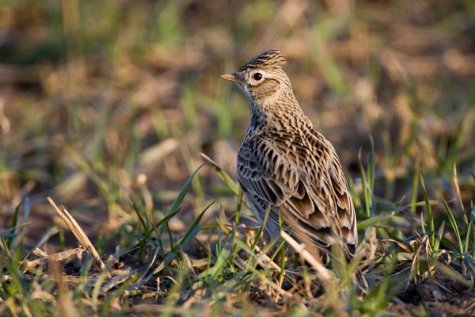More larks day by day
Photo: Arne Ader
Translation: Liis
Skylark
Skylark Põldlõoke Alauda arvensis
Almost everyone is probably familiar with the warbling of this untiring master of song in the sky where we have to look for the singer. But how many of us have managed to watch skylarks and their doings at close quarters?
Passerines that mainly keep to the ground have an advantage in a modest plumage – the brownish grey protective colouring allows the bird to remain almost unnoticed if it freezes in place when somebody passes. The male as well as female have similar plumages, in nature it is impossible to distinguish between them
On the ground skylarks get around mostly walking or running. To check up the surroundings it stops on a higher turf or on a rock (rarely sitting on shrubs or power lines). If you see a lark in flight from a distance the flight image seems billowing and a little trembling. Skylarks feed on the ground, looking for insects and remaining seeds. It is said that that the males arrive in the first migration wave, trying to occupy the best breeding sites; the females up to some weeks later as the case is with many other migrant birds. Many migrants now proceed northwards for breeding.
Both sexes have feathers on the top of the head that are ruffled when the bird is agitated. Eyes and the upper part of the beak are brown as are the legs. The length of the sturdily built skylark stays below 20 centimetres. Back plumage is modestly light brown and the belly plumage whitish, chest covered with light brown streaks. As characteristic marks we can see the white edges on the fairly wide wings and the likewise white-edged tail feathers.
If a ”lark’s winter” should arrive a rapidly melting snow cover of a few days does not bother the skylarks but in case of a cold wave they simply fly back to the southern snow frontier.
The skylarks that breed in Estonia still manage quite well, they are more than half a million pairs. In the cultural landscape of western Europe they have become rarities after decades of intense agriculture and insecticides and chemical weed control …
Skylark observations: LINK









